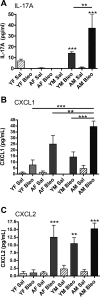Age and sex dimorphisms contribute to the severity of bleomycin-induced lung injury and fibrosis
- PMID: 21743030
- PMCID: PMC3191751
- DOI: 10.1152/ajplung.00122.2011
Age and sex dimorphisms contribute to the severity of bleomycin-induced lung injury and fibrosis
Abstract
Fibrotic interstitial pneumonias are more prevalent in males of advancing age, although little is known about the underlying mechanisms. To evaluate the contributions of age and sex to the development of pulmonary fibrosis, we intratracheally instilled young (8-12 wk) and aged (52-54 wk) male and female mice with bleomycin and assessed the development and severity of fibrotic lung disease by measurements of lung collagen levels, static compliance, leukocyte infiltration, and stereological quantification of fibrotic areas in histological sections. We also quantified proinflammatory and profibrotic chemokine and cytokine levels in the bronchoalveolar lavage fluid. Aged male mice developed more severe lung disease, indicated by increased mortality, increased collagen deposition, and neutrophilic alveolitis compared with aged female mice or young mice of either sex. Aged male mice also exhibited increased levels of transforming growth factor-β, IL-17A, and CXCL1 in their bronchoalveolar lavage fluid. Young male mice developed a more fibrotic disease after bleomycin instillation compared with female mice, regardless of age. There was no difference in fibrosis between young and aged female mice. Taken together, these findings suggest that the variables of advanced age and male sex contribute to the severity of pulmonary fibrosis in this model. Our findings also emphasize the importance of stratifying experimental groups on the basis of age and sex in experimental and epidemiological studies of this nature.
Figures






References
-
- Adamson IY, Hedgecock C. Patterns of particle deposition and retention after instillation to mouse lung during acute injury and fibrotic repair. Exp Lung Res 21: 695–709, 1995 - PubMed
-
- American Thoracic Society/European Respiratory Society International Multidisciplinary Consensus Classification of the Idiopathic Interstitial Pneumonias This joint statement of the American Thoracic Society (ATS), and the European Respiratory Society (ERS) was adopted by the ATS board of directors, June 2001 and by the ERS Executive Committee, June 2001. Am J Respir Crit Care Med 165: 277–304, 2002 - PubMed
-
- Aoshiba K, Nagai A. Chronic lung inflammation in aging mice. FEBS Lett 581: 3512–3516, 2007 - PubMed
Publication types
MeSH terms
Substances
Grants and funding
LinkOut - more resources
Full Text Sources
Other Literature Sources
Medical

